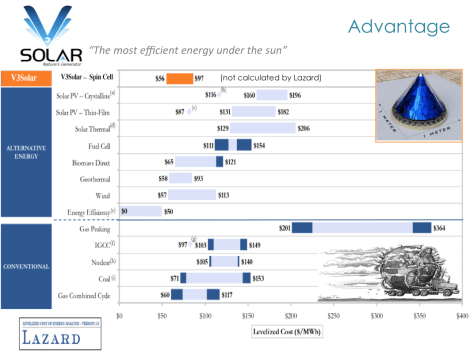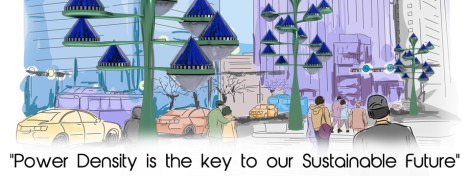Over time I’ve grown more and more suspicious of stories about breakthrough technologies. I always think back to those heady days of EEStor, the guys who were going to make a battery that would revolutionize grid storage and electric cars alike. “EEStor CEO says game-changing energy storage device coming by 2010”! As you may have noticed, 2010 came and went and the game remains unchanged.
All of which is to say, regarding the post to follow: caveat lector.
Still, this looks very, very cool.
CleanTechnica has an exclusive on a new solar technology that claims to be able to produce power with a levelized cost of energy (LCOE) of 8¢/kWh. That is mind-boggling, “two-thirds the price of retail electricity and over 3 times cheaper than current solar technology.” If the claim proves to be true (and a lot can happen between prototype and mass manufacturing), it could revolutionize the solar industry.
The company is called V3Solar (formerly Solarphasec) and its product, the Spin Cell, ingeniously solves two big problems facing solar PV.
First, most solar panels are flat, which means they miss most of the sunlight most of the time. They only briefly face direct sunlight, unless expensive tracking systems are added. The Spin Cell is a cone:
The conical shape catches the sun over the course of its entire arc through the sky, along every axis. It’s built-in tracking.
The second problem: Solar panels produce much more energy if sunlight is concentrated by a lens before it hits the solar cell; however, concentrating the light also creates immense amounts of heat, which means that concentrating solar panels (CPV) require expensive, specialized, heat-resistant solar cell materials.
 The Spin Cell concentrates sunlight on plain old (cheap) silicon PV, but keeps it cool by spinning it.
The Spin Cell concentrates sunlight on plain old (cheap) silicon PV, but keeps it cool by spinning it.
It’s just so damn clever.
Here’s a video that explains:
The company’s technology claims have been confirmed by a technical review commissioned from independent consultant Bill Rever. As to the 8¢/kWh cost claim, the company told CleanTechnica, “We think we can go below that, but we want to stay conservative.” Hitting it, or close to it, could shake up the energy world. Here’s a chart comparing LCOE for various power sources:

V3SolarClick to embiggen.
That is a whole new ballgame right there.
The company’s aim is to capture 3 percent of the energy market. For context, CleanTechnica notes that “all solar power installed in the U.S. to date currently accounts for about 0.5-1% of the energy market.” More than tripling the size of the U.S. solar market is … well, not short on ambition.
Most impressively, to me, the company tells CleanTechnica that it already has over 4 GW of requests for orders. There is 7 GW of installed solar in the U.S., total.
There’s lots, lots more on the technology over on CleanTechnica, if you want to dig in.
To me, the most exciting implications of the technology (again, if it proves out) are for distributed energy. Spin Cells are only a meter across and quite aesthetically appealing. You could carpet a city in these. Like this:
Maybe this tech or this company will peter out before reaching mass-market scale. But advances in solar technology are coming faster and faster. (Small, distributed energy technologies are inherently more prone to innovation than large, capital-intensive energy technologies.) Sooner or later, solar will be woven seamlessly into the fabric of our lives. Our built environment will harvest energy as a matter of course (from the sun, from the wind, from waste), store it effectively, and use it wisely. Power harvesting and power management will be ubiquitous; power imported from large, distant, polluting power plants over long-distance transmission lines will come to be seen as back-up, a necessary evil. And perhaps, someday, an unnecessary one.
——
UPDATE: There are several critiques of V3Solar’s technology in the comments. The company defends its tech against some of them here.





